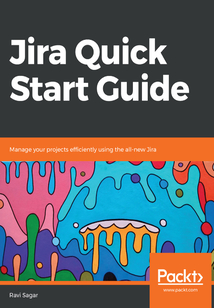舉報 

會員
Jira Quick Start Guide
Jiraisanissuetrackerandprojectmanagementsystem.Withtheirlatestrelease,theJirateamhasnowexpandedtheiruserbasetoagileteamsaswellasbusinessteams.ThisbookprovidesacomprehensiveexplanationcoveringallmajorcomponentsofJira,includingJiraSoftware,JiraCore,andJiraServiceDesk.ThisbookstartswithanintroductiontoJira'suniquefeaturesandhowitcanbeusedasanissue-trackingtool.ItwillthenteachyouabouthowanewprojectiscreatedbyaJiraadministrator,whatresponsibilitiesthereare,andusingcorrectandrelevantschemesinyourproject.Youwillthenlearnhowtoconfigureprojectworkflowsandfieldsforprojectscreens.YouwillunderstandthevariouspermissionsusedinprojectsandtheimportanceofprojectrolesinJira.Then,thebooktalksabouttheconceptsofversionsactingasmilestonesandusingcomponentswhenhandlingissuesinyourprojects.Itwillthenfocusonanalysingdatausingbuilt-inreportsandcreatingdashboardsinJira.Attheend,itwilldiscussvariousbestpracticesforusersaswellasprojectmanagersorprojectadministrators.
目錄(174章)
倒序
- coverpage
- Title Page
- Copyright and Credits
- Jira Quick Start Guide
- Dedication
- About Packt
- Why subscribe?
- Packt.com
- Contributors
- About the author
- About the reviewer
- Packt is searching for authors like you
- Preface
- Who this book is for
- What this book covers
- To get the most out of this book
- Conventions used
- Get in touch
- Reviews
- Introducing Jira
- What is Jira?
- Jira Core
- Jira Software
- Jira Service Desk
- The problems Jira solves
- Challenges and problems that Jira solves
- Lack of flexibility
- Difficulty in customization
- Difficulty in adoption by teams
- Extensive training to learn the tool
- Expensive
- What are the main benefits of Jira?
- Standard tool for teams of all sizes
- Simple licensing model
- Lightweight tool
- Low maintenance
- Ease of use and intuitiveness
- Increased productivity
- Better visibility
- Integration with other tools
- Marketplace apps
- A RESTful API for limitless possibilities
- Atlassian Community
- How to decide which application to use?
- Deployment options
- Cloud
- Server
- Data Center
- Summary
- Getting Started with Jira Core and Basic Usage
- Getting started with Jira
- Planning your Jira installation
- How many users will be using Jira?
- What problems are you trying to solve with Jira?
- Which application and what apps would you need?
- How many projects do you want to create in Jira?
- What will be the projected usage in six months and one year from now?
- Integration with other tools
- Choosing a deployment
- Setting up a Cloud instance
- Using Jira Core for business teams
- Creating a new project
- Working on a Jira Core project
- Summary
- Activity
- Statistics
- Board
- Issues and filters
- Reports
- Working on an issue in a Jira Core project
- Summary
- Using Jira Software for Development Teams
- Using Jira Software for development teams
- Enabling Jira Software
- Overview of Agile concepts
- What is Agile?
- Scrum and Kanban methodologies
- Key Agile concepts
- Roles in Agile
- Is Jira suitable for development projects?
- Scrum board
- Creating a sample Scrum project
- Populating ranking and estimating a backlog using story points
- Planning and creating sprints
- Configuring swimlanes card colors edit card fields and quick filters
- Swimlanes
- Card colors
- Card layout
- Quick filters
- Jira Software reports
- The Burndown Chart
- The Velocity Chart
- Kanban board
- Setting up a Kanban board
- Column constraints
- Summary
- Using Jira Service Desk for Help Desks
- Using Jira Service Desk for help desks
- Enabling Jira Service Desk
- Overview of Helpdesk
- Basic features of any help desk
- Help desk processes
- Different ways to raise tickets
- Creating a Jira Service Desk project
- Using Jira Service Desk
- Customer portal
- Queues
- Customer permissions
- Configuring Jira Service Desk
- Request types
- Portal settings
- Email requests
- Satisfaction settings
- Knowledge base
- SLAs
- Automation
- Jira Service Desk reports
- Workload
- SLA goals
- Satisfaction
- Requests deflected
- Requests resolved
- Created versus resolved
- Time to resolution
- SLA met versus breached
- Incidents reported by priority
- Summary
- Jira Schemes and Configuring Project Workflow
- The various types of user in Jira
- User
- Project administrator
- Jira administrator
- Overview of various schemes in Jira
- Issue type schemes
- Workflow schemes
- Issue type screen schemes
- Field configuration schemes
- Permission schemes
- Notification schemes
- Customizing Jira workflow
- New status
- Creating a new workflow
- Summary
- Configuring Project Screens and Permissions
- Adding new custom fields in Jira
- Understanding Jira screens
- Using the custom field in our project
- Transition screens
- Working with permissions
- Summary
- Reports and Dashboards
- Jira Core reports
- Average Age Report
- Pie Chart Report
- Jira Software reports
- Burndown chart
- Velocity chart
- Jira Service Desk
- SLA success rate
- Satisfaction
- Creating and sharing dashboards
- Summary
- Best Practices
- Setting up a change control board
- Documenting your configurations
- Not creating too many statuses
- Not creating lots of custom fields
- Using contexts
- Using project roles over groups
- Not modifying default configurations
- Jira customization process
- Summary
- Other Books You May Enjoy
- Leave a review - let other readers know what you think 更新時間:2021-07-02 14:00:00
推薦閱讀
- 生源地助學(xué)貸款的可持續(xù)發(fā)展
- 相變
- 大學(xué)生國家認(rèn)同研究
- 齊美爾與后現(xiàn)代社會理論
- 抗震工作文件選編(2000年-2012年)
- R語言與社會科學(xué)調(diào)查數(shù)據(jù)分析
- 工作分析與應(yīng)用(第二版)
- 永恒的中國心
- 殘障權(quán)利研究(第4卷/第1期/2017·夏季號)
- 成行
- 戒癮:戰(zhàn)勝致命性成癮
- 農(nóng)村最低生活保障與扶貧對象動態(tài)管理機(jī)制研究
- 新時代人才觀視域下海外人才回流影響因素研究:以電力行業(yè)博士為例
- 北大公開課:北大才齋講堂精選·教育與心理
- 世界觀:現(xiàn)代人必須要懂的科學(xué)哲學(xué)和科學(xué)史(原書第2版)
- 數(shù)字人文(2024年第1期)
- 近代以來日本的中國觀·第二卷(1603-1840)
- 熵:一種新的創(chuàng)業(yè)方法論
- 協(xié)同型政府
- 管理學(xué)理論與方法
- 中國哲學(xué)社會科學(xué)發(fā)展歷程回憶·文學(xué)卷
- 管理溝通(第2版)
- 胡適文集(第一卷)
- 積極計(jì)算:體驗(yàn)重塑科技未來
- 從控制到引導(dǎo):復(fù)雜性工程學(xué)派的有機(jī)適應(yīng)性理論
- 萬事民為先
- 中國傳統(tǒng)創(chuàng)造思想研究
- 現(xiàn)代辦公實(shí)務(wù)
- 空間正義論:正義的重構(gòu)與空間生產(chǎn)的批判(谷臻小簡·AI導(dǎo)讀版)
- 高效時間管理術(shù)

